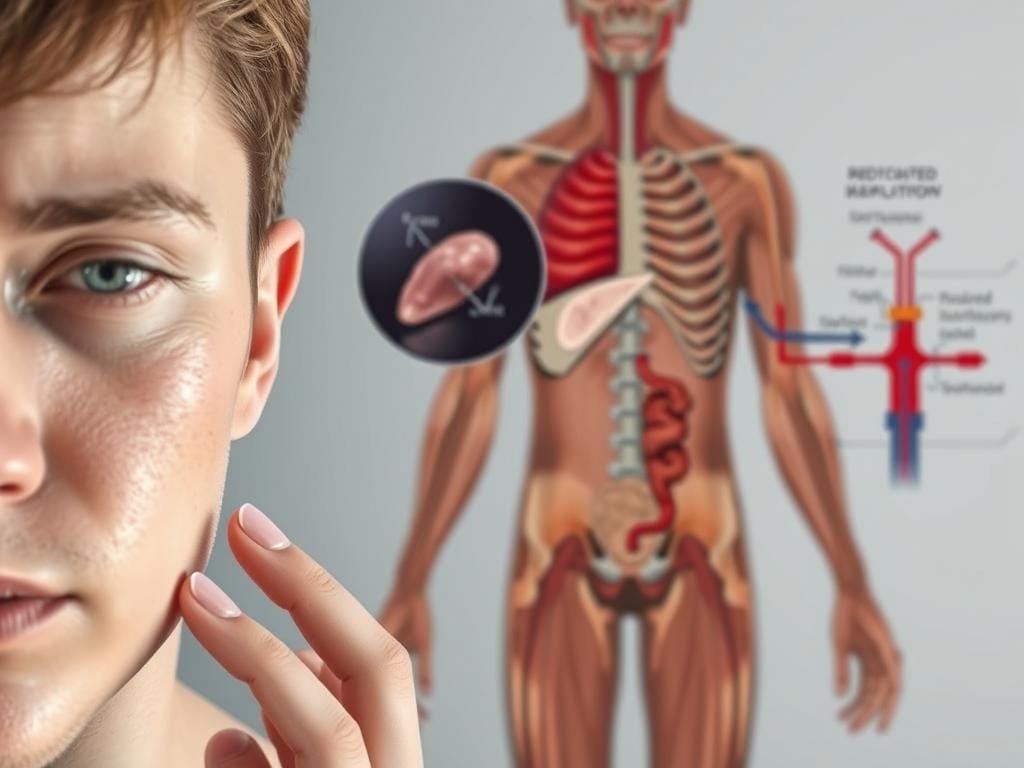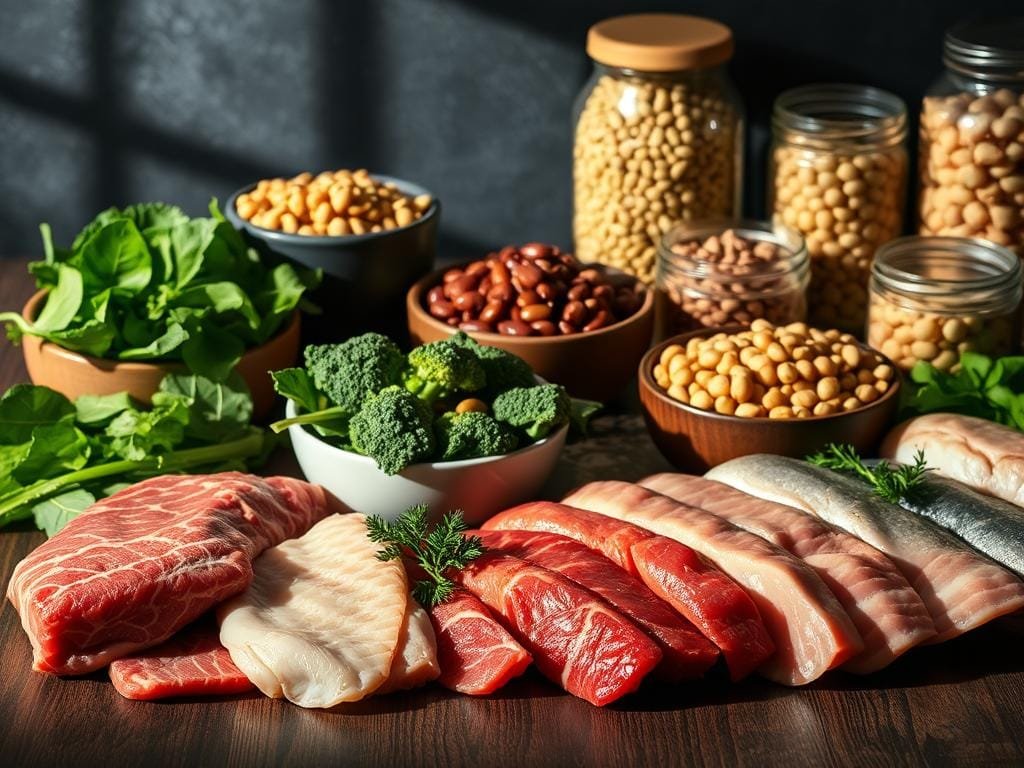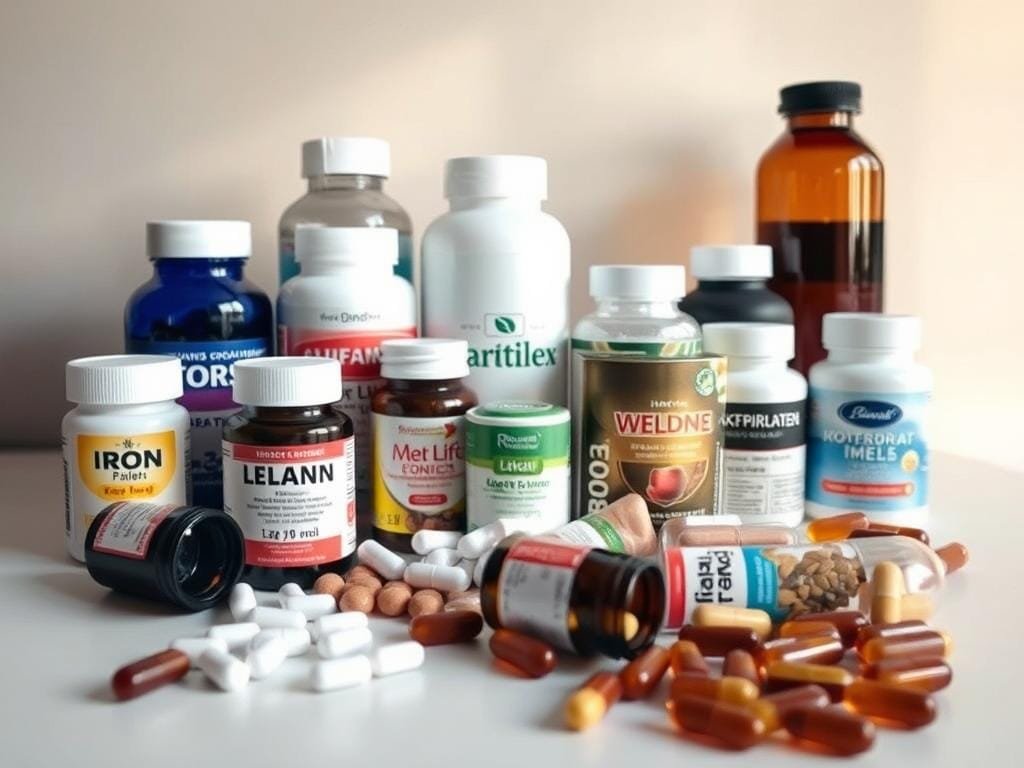Did you know that iron deficiency is a common problem worldwide? It affects millions of people.
The Mayo Clinic says that not having enough iron can cause anemia. This leads to feelings of tiredness and weakness. Eating a diet full of nutrients is key to avoiding these issues. Learning about essential nutrients helps keep your body healthy.
Table of Contents
Key Takeaways
- Iron deficiency is a widespread nutritional disorder.
- Symptoms include fatigue and weakness due to inadequate iron.
- A balanced diet is key to preventing iron deficiency.
- Whole foods are rich in essential nutrients.
- Making dietary changes can help manage iron deficiency.
Understanding Iron Deficiency
Iron deficiency means your body has too little iron. This is bad because iron helps make red blood cells. These cells carry oxygen to all parts of your body.
What is Iron Deficiency?
When your body lacks iron, it can’t make enough hemoglobin. Hemoglobin is a protein in red blood cells that carries oxygen. Without enough, you might get iron deficiency anemia.
Healthdirect says iron deficiency can make you feel tired, weak, and have trouble concentrating. It’s common in many people, but some groups are more at risk. These include women who might have a baby and people who don’t eat enough iron.
The Importance of Iron in Your Body
Iron is key for getting oxygen to your body’s tissues and organs. It also helps your muscles work right and keeps your immune system strong. The importance of iron is huge, as it’s needed for energy and keeping your skin, hair, and nails healthy.
To better absorb iron, eat foods high in vitamin C with iron-rich foods. Vitamin C helps your body take in non-heme iron better.
| Food | Iron Content (mg) | Vitamin C Content (mg) |
|---|---|---|
| Red meat (3 oz serving) | 3.5 | 0 |
| Spinach (1 cup cooked) | 6.4 | 17 |
| Orange juice (1 cup) | 0.2 | 124 |
Knowing about iron deficiency and its role in your body helps. You can prevent or manage it by changing your diet and possibly taking supplements.
Common Symptoms of Iron Deficiency
Iron deficiency can show up in many ways, affecting your health. It’s important to spot these signs early to get help quickly.
Physical Signs to Watch For
Iron deficiency can cause noticeable physical symptoms. You might feel fatigue and weakness, making simple tasks hard. Look out for pale skin, shortness of breath, and cold hands and feet.

Mental and Emotional Symptoms
Iron deficiency can also impact your mind and feelings. You might struggle with poor concentration and difficulty focusing. Some people feel dizzy and lightheaded.
In severe cases, it can lead to depression and anxiety.
When to Seek Medical Advice
If you’re dealing with several symptoms that won’t go away, see a doctor. They can check for iron deficiency with blood tests and treat it. It’s vital to catch it early, as women and children are more likely to be affected.
Causes of Iron Deficiency
It’s important to know the causes of iron deficiency to prevent and treat it. Iron deficiency can come from many sources. These include what you eat, your body’s health, and diseases.
Dietary Causes
Eating too little iron-rich foods can lead to iron deficiency. Without enough iron, your body can’t make enough hemoglobin. This is a big problem. To fix this, eat foods like red meat, poultry, fish, beans, lentils, and cereals that have iron added to them. For more tips, check out Hopkins Medicine.
Blood Loss Factors
Blood loss is another big reason for iron deficiency. Women who menstruate often lose a lot of blood. Other causes include bleeding in the gut, surgery, and giving blood too often. It’s key to find and stop the blood loss to avoid iron deficiency.
Increased Iron Needs
Some life stages and conditions mean you need more iron. Pregnant women need more iron for their blood and the baby’s health. Kids and teens also need more iron as they grow. Making sure they get enough iron is important to avoid deficiency.
Diagnosing Iron Deficiency
To find out if you have iron deficiency, doctors use blood tests. These tests check your iron levels and how bad the deficiency is. If you think you might have iron deficiency, your doctor will do these tests to figure out what to do next.
Tests to Identify Low Iron Levels
There are a few blood tests to find out if you have low iron. These include:
- A complete blood count (CBC) to measure hemoglobin levels.
- Serum ferritin test to assess stored iron.
- Iron level test to measure the amount of iron in your blood.
- Total iron-binding capacity (TIBC) test to evaluate the amount of iron available for binding to transferrin.
These tests give a full picture of your iron levels. They help doctors know if you have iron deficiency. For more info, check out the American Society of Hematology’s page on iron.

Understanding Your Test Results
When your test results come back, your doctor will explain them to you. It’s important to understand your test results to know how to treat your iron deficiency. Low hemoglobin and serum ferritin levels mean you have iron deficiency anemia.
Your doctor will look at your health, medical history, and test results to make a personalized treatment plan. This plan might include changing your diet, taking iron supplements, or other treatments based on your needs.
The Role of Diet in Managing Iron Deficiency
Changing your diet can greatly improve your iron levels. Eating foods rich in iron can help manage iron deficiency. This can lower the risk of health problems linked to it.
Iron-Rich Foods You Should Include
Adding iron-rich foods to your diet is a smart move. Foods like red meat, poultry, seafood, beans, and fortified cereals are high in iron. They can easily be part of your daily meals to increase your iron intake.
Tips to Improve Iron Absorption
It’s just as important to improve iron absorption as it is to eat iron-rich foods. Vitamin C boosts iron absorption. So, eating foods high in vitamin C, like citrus fruits or bell peppers, with iron-rich foods is good. But, avoid drinking tea, coffee, and calcium-rich foods near meal times. They can block iron absorption.
The Mayo Clinic says making smart food choices is key to managing iron deficiency. Knowing which foods to eat and how to improve iron absorption can help improve your iron levels.
Types of Iron in Foods
Knowing about the iron in your food is key to avoiding iron deficiency. There are two main types: heme iron and non-heme iron. Each has its own absorption rate and food sources.
Heme vs. Non-Heme Iron
Heme iron comes from animal products like meat, poultry, and seafood. It’s easier for your body to absorb than non-heme iron. Non-heme iron, found in plants like beans and fortified cereals, is harder to absorb but just as important.
Key differences between heme and non-heme iron:
- Heme iron is absorbed more efficiently by the body.
- Non-heme iron absorption can be enhanced by consuming vitamin C-rich foods alongside iron-rich foods.
Food Sources of Heme Iron
To boost your heme iron, eat more:
- Red meat, such as beef and lamb.
- Poultry, like chicken and turkey.
- Seafood, including clams, oysters, and sardines.
These foods offer heme iron and other nutrients like protein and vitamins.

Food Sources of Non-Heme Iron
For plant-based diets, get non-heme iron from:
- Legumes, such as lentils, chickpeas, and black beans.
- Nuts and seeds, like pumpkin seeds and sesame seeds.
- Fortified cereals and bread.
- Dark leafy greens, including spinach and kale.
To better absorb non-heme iron, eat foods high in vitamin C (like citrus fruits or bell peppers) with your non-heme iron sources.
By understanding and incorporating both types of iron into your diet, you can effectively manage and prevent iron deficiency.
Preventing Iron Deficiency
You can lower your risk of iron deficiency by choosing the right foods and habits. Eating a balanced diet with iron-rich foods is key to keeping iron levels healthy.
Dietary Changes to Prevent Iron Deficiency
Changing your diet is a big step in avoiding iron deficiency. It’s important to eat foods high in iron. Heme iron, found in animal products, is better absorbed than non-heme iron in plants.
To boost iron absorption, eat foods rich in vitamin C with iron-rich foods. For instance, orange juice with cereal can help absorb non-heme iron better.
| Food Type | Iron Content (mg) | Serving Size |
|---|---|---|
| Clams | 28 | 3 oz |
| White beans | 8 | 1 cup cooked |
| Beef liver | 5 | 3 oz |
| Lentils | 6.6 | 1 cup cooked |
Lifestyle Factors to Consider
Lifestyle choices are critical, mainly for women of childbearing age and children. Women with heavy periods are more at risk. For more on iron deficiency in children, check Mayo Clinic’s iron deficiency page.
Also, keep your gut health in check. Issues like celiac disease or surgery can impact iron absorption. Regular health checks and a healthy lifestyle can help manage these risks.
Iron Supplements: Pros and Cons
Iron supplements are a common solution for treating iron deficiency. They come with their own set of considerations. If you’re dealing with low iron levels, understanding the benefits and drawbacks of iron supplements is essential. This knowledge helps you make an informed decision about your health.
Types of Iron Supplements Available
There are several types of iron supplements available, each with different characteristics. The most common forms include:
- Ferrous Sulfate: Often prescribed due to its high iron content and relatively low cost.
- Ferrous Gluconate: Known for being gentler on the stomach compared to ferrous sulfate.
- Ferrous Fumarate: Another form that is commonly used, for those who cannot tolerate other forms.
- Iron Complexes: Such as iron citrate or iron glycinate, which may offer better absorption and fewer side effects.
Choosing the right type of iron supplement depends on your individual needs and how well you tolerate the supplement.

Possible Side Effects and Risks
While iron supplements can be beneficial, they can also cause side effects. These include:
- Constipation
- Stomach upset
- Nausea
- Diarrhea
To minimize these risks, start with a low dose and gradually increase it. Take the supplement with food. For more information on managing side effects and choosing the right supplements, visit health-focused resources that provide guidance on supplement intake.
| Type of Iron Supplement | Common Side Effects | Relative Cost |
|---|---|---|
| Ferrous Sulfate | Constipation, stomach upset | Low |
| Ferrous Gluconate | Nausea, diarrhea | Moderate |
| Ferrous Fumarate | Constipation, stomach cramps | Moderate |
| Iron Complexes | Fewer side effects reported | Higher |
It’s important to follow the recommended dosage and consult with a healthcare provider. They can help determine the best iron supplement for your needs.
Living with Iron Deficiency
If you have iron deficiency, knowing how to manage it is vital for your health. You need to make dietary changes, adjust your lifestyle, and sometimes take iron supplements.
Ways to Manage Symptoms
It’s important to manage iron deficiency symptoms to improve your life. Here are ways to do it:
- Eat more iron-rich foods like red meat, poultry, fish, beans, and fortified cereals.
- Drink foods high in vitamin C (like citrus fruits or bell peppers) with iron-rich foods to boost absorption.
- Stay away from coffee and tea, which can block iron absorption, around meal times.
Also, make sure your diet is balanced. Following your healthcare provider’s dietary advice is also key.
Long-term Health Considerations
For long-term health, keep an eye on your iron levels and treat any underlying issues. Healthdirect says regular doctor visits are vital for managing iron deficiency.
Important long-term steps include:
- Get regular blood tests to check your iron levels.
- Deal with any health problems that might be causing iron deficiency.
- Change your diet and supplement plan as your doctor advises.
By being proactive and informed, you can lessen iron deficiency’s impact on your health.
When to Consult a Healthcare Provider
If you’re feeling really tired, weak, or having trouble breathing, see a doctor. These signs might mean you have iron deficiency, as Mayo Clinic suggests.
Recognizing the Need for Medical Attention
Look out for pale skin, chest pain, or a fast heartbeat. Also, watch for headaches, dizziness, cold hands and feet, and a poor appetite. If you’re a woman with heavy periods, a vegetarian, or donate blood often, check your iron levels closely.
Specialized Care for Iron Deficiency
A doctor, maybe a hematologist, can help with iron deficiency. They’ll tell you the best way to treat it, like changing your diet or taking supplements. Always talk to a healthcare expert before making health choices, as healthcare guidelines recommend.

